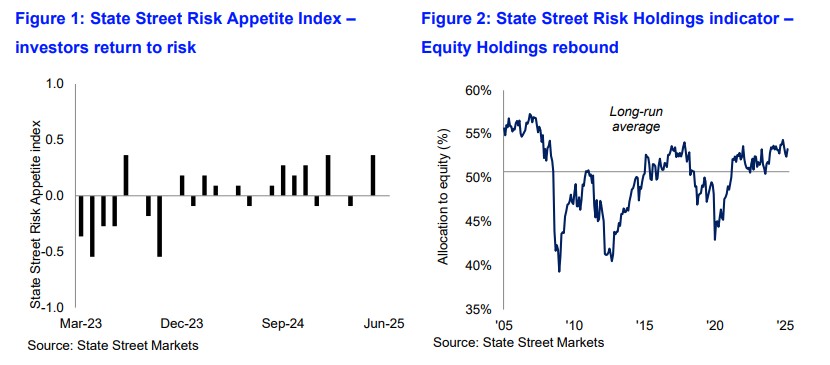Investment Strategies
Investors Put Chips Back On The Table; Worries Linger – State Street

Equity exposure and sentiment has gyrated since the November elections. Recent measures of worry suggest confidence is improving. The State Street indices of sentiment measure what investors are actually doing.
The US administration’s delay in imposing the sweeping
“Liberation Day” tariffs has emboldened investors to put chips
back on the table in equity markets. A State Street risk
barometer suggests that appetite for equities rose in May.
The State Street Risk Appetite Index rose to 0.36 at end-May. The
State Street Holdings indicators show that long-term investor
allocations to equities rose anew in May to levels last seen just
before the 2 April tariff announcement.
During May, exposure to equities rose by 0.9 per cent relative to
a 0.8 per cent fall in bond holdings.

Equity exposure has whipsawed since Donald Trump was elected
President last November. Initially, stocks rose, then fell –
particularly among tech stocks – after revelations about China’s
DeepSeek AI app – and fell dramatically after the tariff
announcement. They’ve subsequently made up ground, although
sentiment remains relatively skittish.
“Fear gauges” such as the VIX Index, which measures options
volatility on the US S&P 500 Index of major stocks, started
at 17.93 per cent on 2 January 2025, rose to almost 28 at
one point in March, and skyrocketed to 52.33 on 8
April after the tariff announcement. Since then, the VIX has
gradually fallen, and was last seen around 17.57 yesterday
late-morning in the UK.
“While the narrative around trade tariffs remains ubiquitous,
implementation delays allied to lower effective tariff rates than
initially envisaged helped lift sentiment towards risk as did the
(still) largely benign environment for inflation that undermines
fears around stagflation,” Dwyfor Evans, head of APAC macro
strategy, State Street Markets, said.
“Protectionism and trade tariffs likely exert a greater impact on
mercantilist Asia than anywhere in the global economy,
particularly given the regional build-up of (predominantly)
dollar reserves. A weaker dollar and higher US yields thus
matter, as do tariffs,” he said.
The State Street risk indicator measures investor confidence or
risk appetite quantitatively by analysing the actual buying and
selling patterns of institutional investors derived from State
Street’s $44 trillion in assets under custody and
administration.
The Risk Appetite Index is derived from measuring investor flows
in 22 different dimensions of risk across equities, foreign
exchange, fixed income, commodity-linked assets, and asset
allocation trends. The index captures the proportion of the
22 risk elements that saw either risk seeking or risk
reducing behaviour. A positive reading suggests that on balance
investors are adding to their risk exposures, while a negative
reading suggests risk reduction. State Street’s holdings
indicators capture the share of investor portfolios allocated
towards equity, fixed income and cash going back to 1998.
ETFs
There are other indications that sentiment about equities – and
US equities in particular – has recovered to some degree.
Although inflows in exchanged-traded funds in May were still well
below the 12-month average, they were positive for the first time
on a three-month view. ETFs focused on Europe saw
lower growth than recently (source: etfbook.com, as
of 30 May).
"Relaxing signals in the trade dispute between China and the USA
impacted the ETF market in May. Investors turned more towards the
USA again," Stefan Kuhn, head of ETF distribution for Europe at
Fidelity International, said.
"It is quite conceivable that Trump's renewed tariff threats
against the EU are already affecting net inflows into European
equity ETFs," he said. Additionally, the markets in Europe have
performed very well this year, Kuhn said: "Investors are asking
themselves how much upside potential European stocks still
have."
Overall, the ETF market grew by $30 billion in May, stronger than
in April.